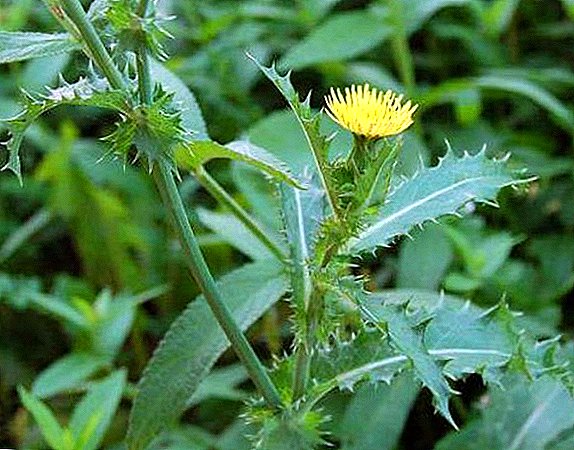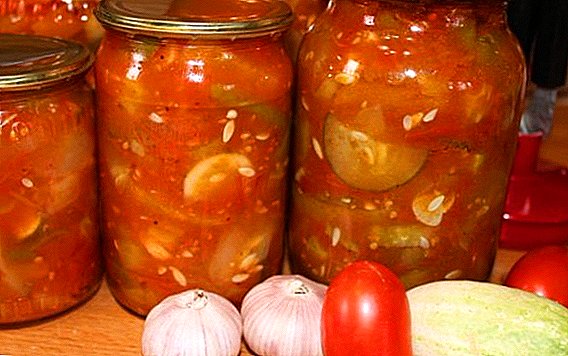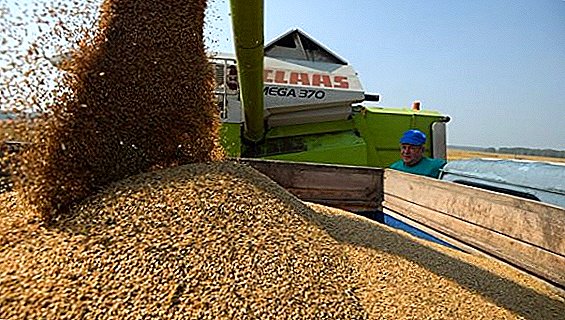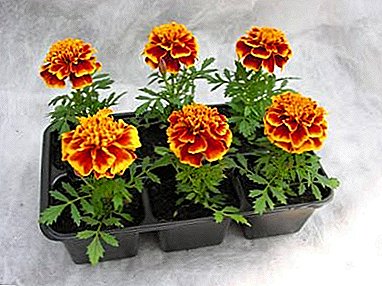
Marigolds (tagetes) - a plant, perhaps the most popular, which many grow in flower beds. But these flowers, thanks to their unpretentiousness, bright color and long flowering, decorate not only the local area, parks and streets, they are often grown on balconies, loggias and window sills.
To decorate your plot, you can buy plants that are ready for flowering, but it will not be difficult to grow seedlings on your own from seeds. It is only necessary to understand what time to sow the seeds, how to care for the seedlings, and where it is better to arrange a flower bed on the site.
In addition, when planting seeds, you can select the desired plant characteristics, especially in the stores offer a wide range of different planting material.
Chernobrivtsy description
On the features of care for undersized marigolds, read here.
The root system is fibrous, the leaves are pinnately dissected or pinnoid-separated, alternate or opposite, the color of the green can be light or dark green.
Baskets inflorescences from yellow to bright orange or brown shades. Flowering begins in June and can continue until the first frost. It is worth noting that marigolds can be sown independently. Germination of seeds trapped in the soil lasts up to 4 years. A pleasant smell does not come from the buds, but from the greenness of the plant.
 In addition, a flower bed with marigolds on the site, this is a priceless home pharmacy.
In addition, a flower bed with marigolds on the site, this is a priceless home pharmacy.
Flowers help in the treatment of the following diseases:
- cataract prevention;
- diabetes;
- spleen inflammation;
- stomatitis;
- asthma;
- bronchitis;
- a cold.
Also, a decoction of dried flowers is recommended to drink during intoxication, to cleanse the blood.
In detail about the healing properties and contraindications to the use of marigolds, we described in this article, and about the features of the use of this plant in traditional medicine and cooking, read our material.
How to grow at home and on the site?
Marigolds have a small growing season and can begin flowering as early as the second month after sowing the seeds. Due to the fact that the plant is unpretentious to weather conditions and transfers small spring frosts, it does not need covering material when sowing seeds directly in open ground or in boxes on the balcony.
It is necessary to plant marigold seeds at a time when a stable temperature is established outside +5. The planting dates are directly dependent on weather conditions, if in regions with a warm climate, seeds can be sown in the ground already in April, then in the middle lane it will be the end of May. Flowering, respectively, occurs in late June and early July.
If you want marigolds to start blooming earlier, then you should apply a seedling method of planting. At home, seedlings are grown, and when warm weather sets in, an adult plant ready for flowering is planted in a permanent place.
Learn more about the features of growing marigolds here.
Seed collection
Marigold seeds are oblong sticks of black color with white tips, which are formed in the center of the flower after it dries. Because seeds retain their germination for more than 4 years, the flowers may be self-growing.
 American breeding varieties germinate later than the French, and hybrids cannot be grown from seeds at all, they may not grow or the parental properties of the new plant will not.
American breeding varieties germinate later than the French, and hybrids cannot be grown from seeds at all, they may not grow or the parental properties of the new plant will not.
How to breed marigold seeds? Seed collection begins in September, in the second half. The main sign for this is wilting of the bushes, especially if the stem has dried near the head - the seeds have ripened. To collect the seed need a dry, windless and sunny weather - the seeds collected during bad weather can dampen and germination will be reduced.
Seeds are harvested as follows.:
- cut the testicle and put it in a ventilated place for drying;
- Then gently open the head with the seeds and shake them on a newspaper.
There is another way to collect seeds:
- to collect flowers in a bunch and hang in a ventilated and dry room above the newspaper;
- as soon as the boxes ripen and open, the seeds themselves can get enough sleep.
Then the seeds are placed in a paper bag and stored until spring sowing.
Growing methods
Marigolds can be grown in two ways - sow directly into the ground, or in separate pots of the house on the windowsill.
It is necessary to consider both of these options in order to accurately determine the time of landing in a particular case. It depends on how early and abundantly the plant will start to delight with its beautiful flowers.
Details on how to grow marigolds at home, read here.
When to sow?
If it was decided to sow the seeds in the ground, then The optimal time for sowing will be May-June depending on the region.. It was during this period in many regions of Russia that the weather was good and steadily warm.
In open ground and on seedlings
Flowers are grown by sowing seed in the soil in the following terms:
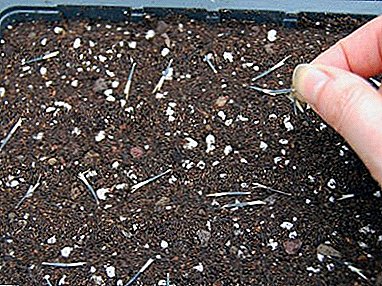 In the winter, after the weather is set steadily cold. The beds must be formed in advance and prepare the ground, which until the time of planting will be in a warm place. As soon as the time of sowing comes, warm earth is poured into the grooves, seeds are sown and powdered with soil. After this, the beds are mulched with compost, rotted sawdust, or old foliage. In the spring, as the snow melts and warm weather sets in, the mulch is removed to quickly warm the ground.
In the winter, after the weather is set steadily cold. The beds must be formed in advance and prepare the ground, which until the time of planting will be in a warm place. As soon as the time of sowing comes, warm earth is poured into the grooves, seeds are sown and powdered with soil. After this, the beds are mulched with compost, rotted sawdust, or old foliage. In the spring, as the snow melts and warm weather sets in, the mulch is removed to quickly warm the ground.- In the spring, around mid-April, the beds are prepared, which should be shed with warm water before and after sowing. It is also desirable to warm the crops, covering with any material.
- In May marigolds can be sown directly in the ground to a permanent place. As soon as shoots appear, they are thinned, leaving at least 10 cm between plants. As soon as 3-5 true leaves appear on the plants, the seedlings are planted, since the optimal distance between adult plants is 30 cm.
Preparatory stage
It should be understood that in order to obtain good seedlings fresh seeds are needed, which have not yet turned two years old, and the soil needs to be prepared fertile and very light.
Before sowing the seeds should be prepared - to germinate, then the seedlings will be quick and friendly. Seeds are placed in cotton fabric, which must first be wetted with warm water. Lay on a saucer and wrap with plastic, food wrap, to create a greenhouse effect. Put the saucer in a warm place and after 2 days check the seeds, if they are of good quality, then the bulk of the planting material will already hatch. Seeds are ready for planting.
Land requirements
The following soil composition will be optimal for sowing marigolds:
- garden land - 1 kg;
- washed river sand - 500 g;
- peat - 1 kg;
- humus or compost - 1 kg.
Sowing
 Planting seeds carried out as follows:
Planting seeds carried out as follows:
- on the beds to make grooves, between which there should be 2 cm;
- spread out the seeds at a distance of 1 cm from each other;
- embedment depth not more than 10 mm;
- shedding warm water;
- fill the seeds;
- Cover the beds with covering material before germination.
As soon as the seedlings appear, the film is removed. This will help to harden the plant for further favorable development and growth.
If the sowing is done by seedlings, the procedure is the same, only after the emergence of the shoots the pot is transferred to a bright, sunny window sill so that the seedlings do not stretch out.
We select the pot
For the cultivation of marigolds fit any capacity - plastic, plastic, containers, boxes, individual cups. It should be noted that seedlings can appear in any container, only there is the main condition - good drainage at the bottom of the pot and openings for drainage of excess water.
Soil selection
The soil can be prepared by independently mixing equal amounts of garden soil, peat, humus and river sand. And you can buy ready-made primer in a specialized store for marigold cultivation.
Care of the cetas
Once the seedlings have grown and planted in a permanent place, the main care will be as follows:
- watering regularly, while in hot weather twice a day - early in the morning and late in the evening;
- constant weeding;
- the formation of a bush with the removal of dried flowers and damaged leaves;
- loosening the soil is carried out 1 time in 7 days, the roots should breathe.
Water properly
 Marigolds love moisture, especially during the active growing season.. But in watering it is necessary to observe not only the uniformity, but also the rate of water.
Marigolds love moisture, especially during the active growing season.. But in watering it is necessary to observe not only the uniformity, but also the rate of water.
It is worth remembering that if watering is abundant, with the stagnation of water, the roots of the plant will begin to rot. With a lack of moisture, the flower may not bloom, or form small, ugly flowers.
During growth, watering should be moderate, and later it will need to be reduced so that there is no stagnant moisture, from which the plants get sick, rot and do not bloom. In the summer heat is better to water in the evenings..
Top dressing
Try not to overfeed the plant with nitrogen fertilizers, as the flower will give a lot of greenery and bloom much later.
The main feeding on the advice of experienced gardeners is carried out three times per season.:
- as soon as the height of the seedling reaches 10 cm;
- with the formation of the first buds;
- at the beginning of flowering.
You can feed the plant and the fourth time during the period of rapid flowering, this will increase the growing season. Top dressing is made by complex fertilizers for the blossoming plants.
Conclusion
The result is to say that marigolds are a photophilous plant, and they should be planted on bright, sunny areas. This culture easily tolerates temperature extremes and lack of moisture. These characteristics allow the plant to be used in decorative floriculture. The same cut plant can stand in a vase without losing its beauty for almost three weeks. But it is not necessary to plant a crop near water bodies or in heavily shaded areas - the taghetses may not bloom or die.


 In the winter, after the weather is set steadily cold. The beds must be formed in advance and prepare the ground, which until the time of planting will be in a warm place. As soon as the time of sowing comes, warm earth is poured into the grooves, seeds are sown and powdered with soil. After this, the beds are mulched with compost, rotted sawdust, or old foliage. In the spring, as the snow melts and warm weather sets in, the mulch is removed to quickly warm the ground.
In the winter, after the weather is set steadily cold. The beds must be formed in advance and prepare the ground, which until the time of planting will be in a warm place. As soon as the time of sowing comes, warm earth is poured into the grooves, seeds are sown and powdered with soil. After this, the beds are mulched with compost, rotted sawdust, or old foliage. In the spring, as the snow melts and warm weather sets in, the mulch is removed to quickly warm the ground.

